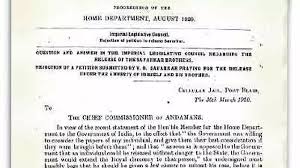
THE REALITY BEHIND VEER SAVARKAR'S MERCY PETITION
Veer Savarkar, a prominent freedom fighter, found himself at the center of controversy following a murder trial that resulted in his life imprisonment in the Cellular Jail of Port Blair. In 1909, Savarkar was arrested in Britain for organizing armed revolts against the British government, particularly opposing the 'Morley-Minto reforms,' which introduced separate electorates for Muslims to purportedly shield them from Hindu dominance in India.
On December 21, 1909, the Magistrate of Nashik District, AMT Jackson, was assassinated by the Abhinav Bharat Society, a group founded by Savarkar to eliminate British officers in India. This led to Savarkar's arrest for conspiring to murder the Nashik collector, cementing his place as a contentious figure in Indian history.
When discussing Veer Savarkar’s legacy, particularly his mercy petition to the British government seeking pardon or a reduction of his sentence, critics often highlight this act. However, this criticism overlooks the brutal conditions Savarkar endured in the Cellular Jail, in stark contrast to the relatively comfortable imprisonment experienced by leaders like Jawaharlal Nehru.
The Cellular Jail in Port Blair, also known as Kaala Paani, was notorious for its horrific conditions. Unlike the somewhat lenient "prisons" Nehru was confined to, the Cellular Jail was a place of severe punishment. The prison was designed to isolate inmates, with each of the 693 cells measuring 4.5 m x 2.7 m, featuring a high ventilator to prevent communication between prisoners.

The jail's three-pronged strategy of hunger, torture, and isolation was particularly harsh. Prisoners like Savarkar suffered immensely, enduring filthy food, unpurified rainwater, and brutal treatment from the wardens. Interaction between inmates was forbidden and punishable by whipping. The prisoners were forced into relentless labor from sunrise to sunset, and protests were met with severe reprisals. In 1933, a hunger strike led to the forced feeding of milk to protesters, resulting in the deaths of two young men from Punjab.
Under such unbearable conditions, it was almost inevitable for prisoners to seek mercy from the British authorities. The inhumane treatment and torturous environment compelled Savarkar to draft a mercy petition, hoping to alleviate his suffering and survive the brutal attempts by the British to crush the spirit of political prisoners fighting for Swaraj.
BUY VEER SAVARKAR T-SHIRT HERE!
In comparison, Jawaharlal Nehru's imprisonment was relatively luxurious. He enjoyed a private cell equipped with amenities such as an armchair, desk, rocking chair, and window. Nehru, born into a privileged family, had connections with British authorities, which afforded him a more comfortable imprisonment, sparing him from the severe hardships faced by Savarkar.

The conditions endured by Veer Savarkar and Jawaharlal Nehru were dramatically different, making it unfair to equate their struggles. Savarkar faced far greater adversity and resistance than Nehru ever did, highlighting the extreme sacrifices made by many freedom fighters, including Bhagat Singh and members of the Indian National Army (INA), in the quest for India’s independence.
[The images used in this blog post are not owned by Anime Devta, they are just for entertainment purposes]
| VEER SAVARKAR | BHAGAT SINGH | FREEDOM FIGHTER | SAVARKAR | INDIAN NATIONAL ARMY | JAWAHARLAL NEHRU | SWARAJ |
~Mimansa Sharma

